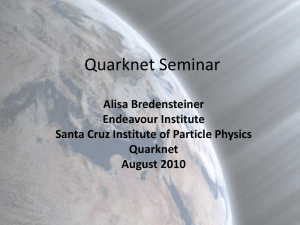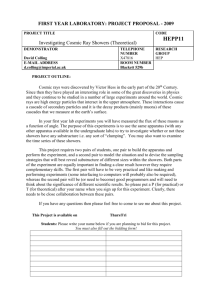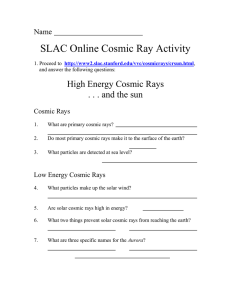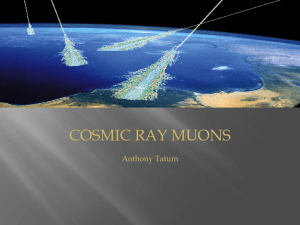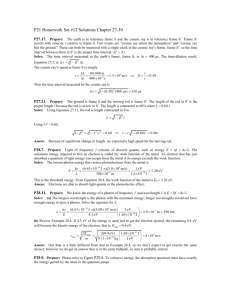Cosmic Rays - High Energy Physics at Wayne State
advertisement
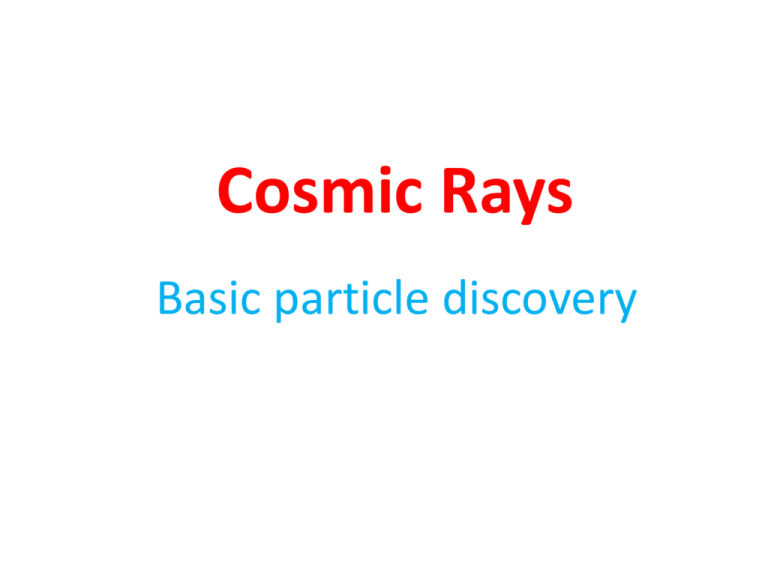
Cosmic Rays Basic particle discovery Cosmic Rays at Earth Cosmic Rays at Earth – Primaries (protons, nuclei) – Secondaries (pions) – Decay products (muons, photons, electrons) 1-2 per second Sources of Cosmic Rays Sources of Cosmic Rays – Supernova remnants – Active galaxies (?) – Quasars (?) – Gamma Ray Bursters (?) – Dark Energy (?) What are Cosmic Rays? • Particles accelerated in astrophysical sources incident on Earth’s atmosphere • Possible sources include solar activity, supernovae, rotating neutron stars, and black holes • Composition: primarily protons and helium nuclei. Remainder is composed of heavier nuclei and electrons Air Shower • Secondary particles are produced, primarily pions • The neutral pions decay to photons, which produce electrons and positrons • The charged pions decay to muons via the weak reactions Air Shower CR shower video (if fast connection): http://astro.uchicago.edu/cosmus/projects/aires/protonshoweroverchicago.mpeg Air Shower • • • The pions decay before they reach sea level The photons, electrons, and positrons are absorbed by the atmosphere due to interactions with atomic fields The muons can reach sea level because: 1) Even though they decay, they have sufficiently long lifetime such that the more energetic muons reach sea level before decaying 2) Unlike electrons (which are much lighter) they do not interact with atomic fields so easily The neutrinos interact only weakly, so they easily reach sea level (and continue straight through the earth) Particle Fluxes • At sea level (altitude 0) the muon and neutrino flux dominates • Approximately one cosmic ray muon passes through your thumbnail every minute! Muon Decay • Muons decay with a mean lifetime of 2.2 μs(mean lifetime = time for an assembly of decaying particles to be reduced by a factor of e) • If a muon is created in the upper atmosphere (e.g. at h = 10 km) does it make it to sea level? • We would expect that even if the muons are traveling at close to the speed of light, the average distance they would travel before decaying is 5 km. • i.e. they would not make it to sea level Special Relativity • According to special relativity, from our point of view time passes more slowly in a system that is in motion relative to us • Thus, the moving muon “clock” ticks more slowly. • This effect is called time dilation and is described by the simple formula: • Thus, the faster moving muons (e.g. those with speed v=0.998c) will travel on average (c=speed of light=3X10⁸meter/sec) • So, the faster moving muons make it to sea level! Energy Spectrum of Cosmic Rays • Cosmic rays can have energies above 10²⁰eV. Far higher than energies of beams available in modern accelerators (eV (electron Volt) is a measure of energy commonly used for particles) Cosmic Ray Energy comparison • LHC at CERN pp collider with CM energy of 14 TeV LHC (Large Hadron Collider) pp (proton – proton) CM (Center of Mass) T=Terra=10¹² • Cosmic rays are equivalent to pp collider with CM energy of 433 TeV ( approx 30 times greater) QuarknetCosmic Ray Detector • Our Quarknet cosmic ray detector is a simple “benchtop” detector consisting of scintillation detectors read out using photomultiplier tubes Cosmic Ray Muon Detector (CRMD) CRMD Typical QuarkNet Detector Setup 1. Counters-scintillators, photomultiplier tubes (two shown) 2. QuarkNet DAQ board 3. 5 VDC adapter 4. GPS receiver 5. GPS extension cable 6. RS-232 cable (to link to computer serial port) 7. Optional RS-232 to USB adapter (to link to computer USB port instead of serial port) 8. Lemo or BNC signal cables 9. Daisy-chained power cables Data Acquisition(DAQ) Card DAQ hardware measures: – Light pulse timing. – Ambient temperature. – Atmospheric pressure. Experiments include: – Flux studies. – Time correlation. – Shielding. – Particle speed. – Particle lifetime. – Altitude attenuation. Scintillators • Produce a short pulse of light in response to charged particle passing through • Two types: inorganic and organic • Organic scintillator (used in our detector):Typically plastic doped with dye molecules • Mechanism is excitation of molecular levels in primary fluorescent material which decay with emission of UV light • Conversion to visible light achieved via fluorescent excitation of dye molecules ( “wavelength shifters”) Photomultiplier Tube • Photon incident on photocathode • Liberates electrons by photoelectric effect • Electrons accelerated to 1st dynode • Secondary electrons emitted • Using ~12 stages can get amplification of ~10⁷–10⁸ times • Electron cascade collected at anode –induces signal Counter Configuration Types of Counter Configurations: 1) Array --> shower Counters distributed in the same plane 2) Stacked --> flux Counters spaced on common center • Determined by type of study • Student defined
